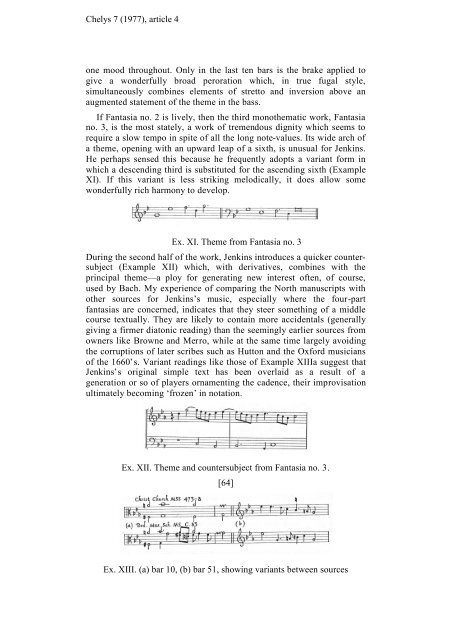download.pdf - 6.3Mb - Viola da Gamba Society
download.pdf - 6.3Mb - Viola da Gamba Society
download.pdf - 6.3Mb - Viola da Gamba Society
Create successful ePaper yourself
Turn your PDF publications into a flip-book with our unique Google optimized e-Paper software.
Chelys 7 (1977), article 4<br />
one mood throughout. Only in the last ten bars is the brake applied to<br />
give a wonderfully broad peroration which, in true fugal style,<br />
simultaneously combines elements of stretto and inversion above an<br />
augmented statement of the theme in the bass.<br />
If Fantasia no. 2 is lively, then the third monothematic work, Fantasia<br />
no. 3, is the most stately, a work of tremendous dignity which seems to<br />
require a slow tempo in spite of all the long note-values. Its wide arch of<br />
a theme, opening with an upward leap of a sixth, is unusual for Jenkins.<br />
He perhaps sensed this because he frequently adopts a variant form in<br />
which a descending third is substituted for the ascending sixth (Example<br />
XI). If this variant is less striking melodically, it does allow some<br />
wonderfully rich harmony to develop.<br />
Ex. XI. Theme from Fantasia no. 3<br />
During the second half of the work, Jenkins introduces a quicker countersubject<br />
(Example XII) which, with derivatives, combines with the<br />
principal theme—a ploy for generating new interest often, of course,<br />
used by Bach. My experience of comparing the North manuscripts with<br />
other sources for Jenkins’s music, especially where the four-part<br />
fantasias are concerned, indicates that they steer something of a middle<br />
course textually. They are likely to contain more accidentals (generally<br />
giving a firmer diatonic reading) than the seemingly earlier sources from<br />
owners like Browne and Merro, while at the same time largely avoiding<br />
the corruptions of later scribes such as Hutton and the Oxford musicians<br />
of the 1660’s. Variant readings like those of Example XIIIa suggest that<br />
Jenkins’s original simple text has been overlaid as a result of a<br />
generation or so of players ornamenting the cadence, their improvisation<br />
ultimately becoming ‘frozen’ in notation.<br />
Ex. XII. Theme and countersubject from Fantasia no. 3.<br />
[64]<br />
Ex. XIII. (a) bar 10, (b) bar 51, showing variants between sources
















